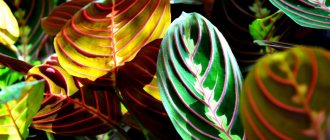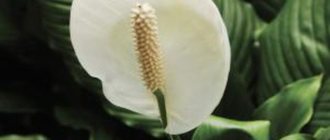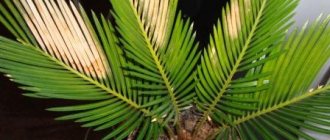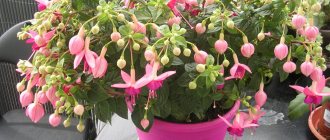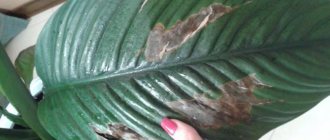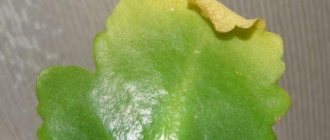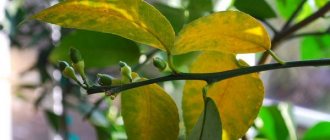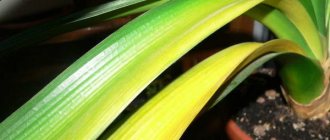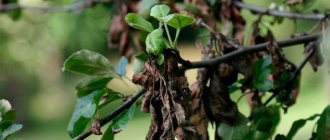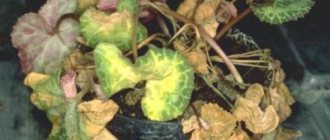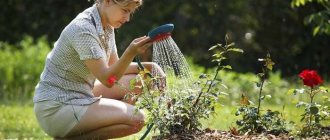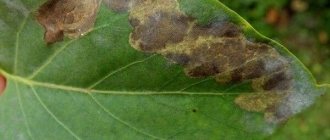Schefflera is a small evergreen tree that grows mainly in the tropical pole of our planet, and is familiar to almost every gardener. Compared to other trees, their growth is not at all small (from 1 to 2.5 m), and its decorative varieties reach a maximum of 1 m in height.
Schefflera is remembered, first of all, for its unusual leaves (their palmate-disseminated structure). In their unusual shape and size, they resemble a small palm, and their number on one branch varies from 7 to 12. The color of its foliage also depends on the type of tree (in one case they can be bright green, and in another, for example, white -yellow with characteristic stains).
Rules of care
When caring for a cheflera, you must follow a few simple rules:
- Placement of the pot . It is best to place it on a windowsill on the east or west side, where there is the greatest amount of sunlight.
- Temperature and humidity in the room. It is also necessary to constantly monitor the temperature and humidity in the room where our tropical guest lives. Optimal indicators: temperature - about 25-30 degrees Celsius, air humidity - no more than 25%.
- Lighting is an important factor when growing such a specific plant. Sheflera is quite light-loving and therefore, not only during the day, but also at night, it should receive a sufficient amount of light. If during the day, of course, the sun will help you with this, then at night - a bright lamp.
- Watering . It is imperative to follow the watering regime. Remember, a tree cannot withstand excess moisture and you need to constantly monitor the moisture level of the soil in which it grows. Excessive moisture will cause the plant itself to rot. Water for irrigation should be filtered and be at the same temperature as the soil (slightly above room temperature).
- be fertilized during the period of its active upward growth (that is, during the period from early autumn to late spring). Fertilization occurs once every 10 days, mainly with a universal natural fertilizer for ornamental trees.
How to defrost a shefflera. The most famous methods.
Today, many experienced gardeners know everything about how to propagate this unpretentious and simple plant. But for beginners in this business, our recommendations will be very helpful. So, the main methods of propagating cheflera at home are as follows:
- by propagation by cuttings;
- through seed germination;
- by propagation by layering.
In addition, it is important to remember that without knowledge of the specifics of caring for a cheflera flower, none of these methods will fully guarantee positive results.
The simplest of them is propagation of cheflera by cuttings. To do this, we recommend using semi-lignified cuttings, which are cut in the spring. Next, root the cuttings in water or take a substrate, for example, add sand (necessarily coarse-grained) to regular soil, follow the proportions 1:1. Before this, the places where the cuttings are cut need to be treated with a special root formation stimulator to make rooting easier.
If you use water for rooting, when the roots appear and develop (fastest in Schefflera, a solid green color; in variegated ones, after 4 weeks), plant the cutting itself in the ground, cover it with a bag, after making a hole for air to enter. But at the same time, do not forget to remove the bag every day 1-2 times, the plant should be ventilated for 20-30 minutes.
When rooting in the substrate, the bag should be put on immediately and ventilated according to the same scheme. Do not over-moisten the substrate; it should be kept slightly moist.
The second method is propagation of sheflera through seed germination. Unfortunately, cheflera cannot obtain the fruits of their seeds at home. Therefore, purchased seeds are planted in winter, mainly January-February, but also in March. The soil must be loose, air and moisture permeable. You can use two types of soil mixture that are perfect. We recommend peat with sand or a handful of sand and a liter of soil. The seeds go deeper into the ground about half a centimeter. Next, water, cover with film and place in a place with an acceptable temperature of 22-25 degrees Celsius. It is enough to ventilate the flower once a day, while removing the film. The pot where the seeds were sown must have drainage and a hole to drain excess water. When seedlings appear, the plant will require a brighter habitat. Create an air temperature within 15-17 degrees Celsius. When summer comes, do not forget to spray your baby cheflers with warm, not cold, water.
Reproduction of sheflera by layering will be interesting, provided there is a large version of this flower. When spring comes, cut the trunk of the plant
It is important to wrap the cut area with a layer of green moss, and then cover it with a layer of film. Moss must be wet
After a month, maybe a little later, roots appear and then the stem can be cut off at the bottom of the new roots and planted in soil made from a 1:1 mixture of peat and sand. When the sheflera has new leaves, feel free to replant it in its usual place.
Just a few simple rules and recommendations and the chef will happily greet you with his open palms!
Transfer
The youngest bores need to be replanted once a year, since their root system is actively developing and it becomes quite cramped for them in the old pot. Remember, the pot should be slightly larger than the previous one. You also need to provide the tree with reliable support for its trunk; to do this, place a medium-thick layer of expanded clay on the bottom of the pot.
The best soil for replanting is the following composition:
- 2 parts turf soil.
- 1 part leaf.
- 1 part humus soil.
- Finally, add some sandy sand.
It is important to know: if you need to replant a plant that has already sprouted shoots, do not disturb the roots and earthen ball under any circumstances. If the plant is completely rooted in the ground, then replanting it is quite dangerous and it is better not to do this, since there is a high probability of damage.
Signs of plant damage
Plants with smooth leaves are most susceptible to attacks by these pests, because the fluff prevents them from firmly attaching themselves to the victim. It is not easy to notice signs of infection at the very beginning. When there are few scale insects, they settle on the lower sides of the leaf blades. Most often, the owner is alarmed by the appearance of sticky discharge - honeydew.
As the colony grows, the following symptoms appear:
- The most characteristic feature is tiny round tubercles , painted in different shades of yellow, greenish, brown, white or red. Leaves become covered with spots. Scale insect colonies look like pale growths. Their favorite habitat is the veins on the leaves.
- The shoots and leaves turn yellow and dry out, the buds fall off before they have time to open. This is a signal that the plant is heavily damaged by insects, which prevent the flow of moisture and nutrients to the various organs of the flower.
- The more the colony grows, the larger the area the tubercles occupy.
If you do not immediately get rid of scale insects on indoor plants, growth stops and over time the flower dies.
Reproduction methods
Sheflera can be propagated in several ways:
- Using cuttings.
- With the help of layering.
- Using seeds.
It is important to know: as soon as some types of plants produce seeds, methods 1 and 2 are most often used, which we will consider in detail.
Shefflera cuttings
In the case of cuttings , fully formed cuttings are cut and treated with a solution to stimulate growth. Then, the cuttings are planted in previously prepared and treated soil, watered and fertilized. And finally, the planted cuttings will need to be covered with a transparent film to create a greenhouse effect and ensure the optimal temperature for the start of active growth.
In order to get healthy cuttings, you need to make a small cut on the plant itself, from where you will take, so to speak, the raw materials. After removing the cuttings, the cut is covered with a film to avoid the formation of moss or parasitic fungi on it. In the case of layering, it is imperative to maintain the optimal temperature for the plant (remember, it is 22-30 degrees Celsius). Within a few months, the first roots will appear, which can already be transplanted from each other into separate small pots, or they can be planted in a large common container.
Propagation of schefflera by cuttings and transplanting seedlings at home
Reproduction: by seeds, cuttings, with preliminary cutting, air layering.
This process is quite complex, and not everyone manages to grow good planting material.
The most effective way to propagate Schefflera is by air layering. To do this, make a shallow cut on the trunk of the plant in the spring with a sharp knife. It is wrapped in moss, constantly moistened and covered with polyethylene.
After 50-60 days, roots will appear at the incision site. The top is separated and transplanted into a separate pot. Don't throw away the old plant; very soon it will sprout side shoots.
For propagation by cuttings, you can use material from shefflera after pruning and shaping the crown. But the likelihood that they will take root is quite low, since the sprouts are too young.
As a rule, for propagation using cuttings, they take material with an already slightly woody stem. Its base is cut and placed in water with phytohormones diluted in them. You can also plant directly into the soil.
Propagation by seeds is very difficult, so it is not used so often. But if all stages are carried out correctly, good germination of the seed can be achieved.
Using Schefflera seeds, it is also possible to propagate it at home. Winter is a suitable period for sowing material. Planting of seeds occurs in a soil mixture of sand and peat, taken in equal proportions.
You can also use light wood and leaf soil with the addition of sand. The soil must be disinfected before planting.
Before planting, the seeds are soaked in warm water, in which drugs that accelerate the growth process (Epinom or Zirconom) are diluted. The depth at which the prepared material should be planted is two times the length of the seed.
The soil in which shefflera is planted during propagation by cuttings or seeds must be moistened with a spray bottle. Next, the soil in the flowerpot or box with planting material should be periodically moistened in the same way.
For schefflera seeds, it is a good idea to organize bottom heating, which will increase germination several times.
After the seedlings produce their second or third leaf, they should be transplanted into larger pots. Here they will spend the next three months; it is necessary to maintain the temperature within 20°C.
When the clod of earth is entwined with the roots of the young shefflera, the seedling is transplanted. At home, during this period the plant needs a pot with a diameter of within 9 cm. The growth of seedlings will be very fast, so the next transplant is needed by the fall.
Varieties
- The eight-leaf sheflera, among all its fellows, is distinguished by its rather unusual appearance (shape) and number of leaves (on one petiole there can be from 8 to 12 leaves the size of a child’s palm). The leaves of a young tree are olive-green, while those of an older tree are green.
- Tree-like . In size, the small tree has a straight trunk. The young tree is decorated with light green leaves that darken over time. The leaves of the tree are also small (up to 20 cm). Most often, this subspecies of the plant is grown as a home culture for Scheffler.
- Radiation is also often grown indoors. This species is also called tree-like because of its small stature. The plant also has several well-developed trunks. The leaves, unlike the tree-like sheflera, are quite large (their minimum size is 30 centimeters).
- Palmate Schefflera is a fairly compact plant, which is most convenient to grow at home, since it does not take up much space and does not require particularly frequent care. The oblong, large leaves look very unusual and impressive.
Eight leaf
Tree-like
Radifolia
Palmate
Geisha girl
Gold Capella
Variegata
Janine
Other artificially bred species of this plant:
- "Geisha Girl" - with dark green leaves, rounded at the ends;
- “Gold Capella” - distinguished by the presence of yellow and light green spots on dark green leaves;
- "Hayata" - has oval-elongated leaves of light green color, narrowed at the ends;
- "Variegata" - has yellow spots on dark green leaves;
- "Janine" is one of the "compact" species, the plants of which do not exceed 1-2 meters in height. It is distinguished by unusual dark green leaves, forked and rounded at the ends, with cream spots and stripes.
Schefflera - leaves fall
Schefflera is an ornamental plant belonging to the Araliaceae genus.
The beautiful large leaves of sheflera grow from one point, like rays or spokes, thanks to which the plant acquired its second name - “umbrella tree”. Sheflera does not need special care; she is quite unpretentious. But if the maintenance conditions are not met, the leaves of the sheflera fall off. It will be useful for flower lovers who have an evergreen bush in their collection to know why the sheflera sheds its leaves.
Conditions of keeping shefflers
In order to find out why the leaves of the cheflera fall off, and what to do if this phenomenon occurs, you should understand what conditions are especially comfortable for the ornamental plant.
Sheflera is native to the humid, warm tropics, so the house plant also requires fairly bright, diffused light.
The plant requires moderate watering and high air humidity; therefore, the leaves should be sprayed regularly.
Schefflera leaves are falling - reasons
- Schefflera sheds its leaves if the temperature is not maintained.
Moreover, both excessively high and low air temperatures are unfavorable for the plant. If the leaves of the sheflera darken and fall off, but the trunk is still alive, then the flower can be saved by replanting. To do this, dry branches are cut off (it is advisable to sprinkle the sections with crushed charcoal or treat them with aniline dyes, for example, brilliant green). Then the plant is transplanted into a new pot by transshipment, without disturbing the root system. A nutritious soil mixture is used for planting. The transplanted shefflera is placed in a well-lit, fairly warm place. - If the cheflera not only loses its leaves, but also its roots have rotted, then this indicates excessive watering, especially at low air temperatures.
The plant can be revived by removing the rotten roots and holding it for 2 hours in a solution of zircon or epin. Next, the roots are treated with a fungicide, and the flower is planted in a pot. The sheflera bush is sprayed with a solution of epin (zircon) and wrapped in polyethylene for 2 - 3 days, which should be removed from time to time for ventilation. After restoration, it is necessary to adjust watering, moistening the soil only if it has already dried out. - Often, sheflera leaves turn black and fall off due to insufficient air humidity.
It is recommended to spray the flower with a spray bottle several times a week, and daily in summer. The plant should also be kept away from heating radiators. - Drafts are detrimental to sheflera; this causes the edges of the leaves to become brown and brittle. It is necessary to choose a place to keep the indoor plant that is not exposed to air currents.
- The appearance of spots on leaves may be due to insufficient soil aeration. The soil in which sheflera grows must always be loose.
- Often the reason for the loss of the decorative qualities of the plant is the defeat of the cheflera by pests: thrips, scale insects, spider mites.
In this case, the leaves curl and fall off, the growth of the flower slows down and, if the parasites are not destroyed, it dies. The damaged plant must be temporarily isolated from other indoor flowers. Pests should be removed with a soft cloth soaked in a water solution of laundry soap.In case of severe infection, you can treat the plant with karbofos or actellik at the rate of 20 drops per liter of water.
| Why do orchid buds wither? The beautiful orchid is valued for its unusually beautiful long flowering, which flower growers look forward to. The buds are about to bloom, but suddenly you notice that they are beginning to wither. What happened? | Kalanchoe calandiva is an unusually beautiful flowering succulent plant. Caring for it is simple, and under the right conditions, calandiva will delight you with a bright head of inflorescences. We'll tell you how to grow this plant at home. |
| Bougainvillea - care at home Bougainvillea is a real tropical beauty, with amazingly bright and lush flowering, and very unpretentious in care. In our article we will tell you how to care for bougainvillea so that it grows and pleases you. | Tulips at home The variety of colors of tulips is a real decoration of the garden. However, those who do not have their own plots can easily start growing flowers at home. We'll tell you how to grow tulips in pots. |
Trimming
An important stage in caring for our tropical guest is timely pruning as a necessary measure. Remember, if you want a beautiful and lush plant that will delight you with its flowering all year round, then from time to time you need to trim its top.
After such a simple procedure, the tree will sprout new beautiful and, most importantly, healthy shoots, which can also be used to propagate cheflera. Also, in a similar way, the image of a round crown is formed, which can give your tree a somewhat decorative and well-groomed look. A similar effect can be achieved by trimming the side edges of the plant.
Diseases and pests
Diseases
- Lack of lighting negatively affects the health of the tree itself. The color of the leaves fades, and the plant itself begins to slowly, but unfortunately, surely die. It is possible to pull a plant out of such a difficult situation; you just need to move it to a more illuminated place.
- Excessive soil moisture , as mentioned above, leads to the process of rotting in the roots of the plant, which can ultimately kill the plant. Due to such improper handling, dropsy will soon begin to appear on the tree, and the leaves will fall off. In this case, it is unlikely that the plant will be saved. Therefore, always monitor the moisture level of the soil in which it is located.
Pests
- Aphid.
- Spider mite.
- Shield.
Aphid
Spider mite
Shchitovka
If these enemies are detected, it is recommended to treat the tree with a regular soap solution, copper preparations, and it is also recommended to increase the air humidity in the room, since these pests cannot tolerate excessive air humidity.
It is important to know: gardening specialists recommend using copper preparations only in cases where the other 2 methods listed above did not produce any results.
Air temperature
The sheffler needs to be kept at a temperature of +22° C. Like lighting, the temperature must be kept above zero at all times. There is no need to raise it, creating the tropics, but a comfortable home one will suit you just fine. Problems begin when the cheflera freezes slightly. The symptoms are especially pronounced if the plant is flooded or sprayed in a draft. It is better to reduce watering for a while by restoring the sheflera. Follow developments.
Nutrients in the soil
Schefflera is fed regularly. If there is not enough fertilizer, it turns yellow, starting from the lower leaves. other problems with the soil mixture, such as too dense a ball of earth, lack of loosening, replanting was carried out a long time ago, etc. cause similar indicators. The cheflera also reacts poorly to any interference in her peace - she drops her leaves instantly, which is why they refuse to replant for so long.
It is carried out by completely changing the soil substrate, but without removing the root balls, otherwise the small hairs will be damaged. It is necessary to apply “Epin” or “Zircon”, also treating it during the transplantation process, in order to protect against unforeseen consequences. How to move the shefflera without causing too much damage: transfer it from one pot to another.
Watering chefleras
The plant is watered moderately. Unlike its brutal appetite for light and temperature, the plant prefers moderation in moisture. The result of frequent and unconditional procedures can be yellowing of the foliage. Since the roots are hypersensitive, they quickly rot, then restoration takes longer and is more difficult - it’s better not to allow them to do so.
Bad place
At the beginning of the article, we already considered the main criteria for placing shefleras in the house, which must be adhered to. Find a comfortable place for the plant with plenty of lighting, warmth, without drafts and temperature changes. It is advisable that the cheflera’s leaves should not be touched again, not torn off, or the tree moved - the cheflera will also react extremely sharply to such tenderness. If yellowing is caused by stress, it is enough to water it with Epin to calm the nervous plant.
Lack of moisture Insufficient water in the soil is not so detrimental to the plant, but it also harms it. First of all, the decorative appearance suffers. Such specimens are weakened and more susceptible to disease. Their leaves begin to lose turgor, wither and fall off. Too dry air causes black spots to appear on the leaves. In addition, in such conditions, the risk of spider mites, which love dry air, increases. Therefore, you need to periodically spray the plant and follow the watering regime. Top dressing Excess mineral fertilizers, and especially nitrogen, causes burns to the root system. It begins to function poorly, and the foliage turns yellow. Lighting Each plant has its own light requirements. Some people like darker places, while others are not afraid of the burning rays of the spring sun. Sheflera belongs to the category of those that love well-lit places, but cannot tolerate exposure to sunlight. Direct rays can burn the flower and the leaves will become yellow and limp. Lack of light does not cause such manifestations, but the pattern on the leaves will be practically invisible. Temperature The optimal temperature for sheflera is the range of +17-22 degrees. The plant does not tolerate increased temperatures well. The leaves lose turgor and begin to wither. Pests and diseases Leaves may fall off due to the appearance of pests. But this usually happens when there are a lot of pests and the plant is severely damaged. The most common ones that may appear are spider mites, aphids and scale insects. Aphids and mites feed on the sap of the plant and deplete it. But it is not always possible to notice pests right away. Spider mites are very small and almost invisible. But its appearance can be recognized by the thin web entangling the leaves and stems. Aphids are slightly larger in size, but the insects live under the leaves, so they are also almost invisible. The best way to control pests is with chemicals - insecticides. The sooner the treatment is carried out, the less the flower will suffer. Without help, the shefflera may completely lose its leaves, stop photosynthesizing and die.
